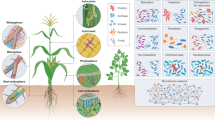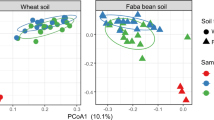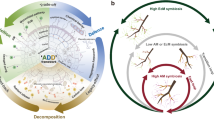Abstract
Highly diverse microbial assemblages colonize plant roots. It is still poorly understood whether different members of this root microbiome act synergistically by supplying different services (for example, different limiting nutrients) to plants and plant communities. In order to test this, we manipulated the presence of two widespread plant root symbionts, arbuscular mycorrhizal fungi and nitrogen-fixing rhizobia bacteria in model grassland communities established in axenic microcosms. Here, we demonstrate that both symbionts complement each other resulting in increased plant diversity, enhanced seedling recruitment and improved nutrient acquisition compared with a single symbiont situation. Legume seedlings obtained up to 15-fold higher productivity if they formed an association with both symbionts, opposed to productivity they reached with only one symbiont. Our results reveal the importance of functional diversity of symbionts and demonstrate that different members of the root microbiome can complement each other in acquiring different limiting nutrients and in driving important ecosystem functions.
Similar content being viewed by others
Log in or create a free account to read this content
Gain free access to this article, as well as selected content from this journal and more on nature.com
or
Accession codes
References
Al-Mufti MM, Sydes CL, Furness SB, Grime JP, Band SR . (1977). A quantitative analysis of shoot phenology and dominance in herbaceous vegetation. J Ecol 65: 759–791.
Bauer JT, Kleczewski NM, Bever JD, Clay K, Reynolds HL . (2012). Nitrogen-fixing bacteria, arbuscular mycorrhizal fungi, and the productivity and structure of prairie grassland communities. Oecologia 170: 1089–1098.
Bécard G, Piché Y . (1992). Establishment of vesicular-arbuscular mycorrhiza in root organ culture: review and proposed methodology. In Norris JR, Read DJ, Varma AK eds Methods in Microbiology Vol. 24 Academic Press: London, pp 89–108.
Berendsen RL, Pieterse CM, Bakker PA . (2012). The rhizosphere microbiome and plant health. Trends Plant Sci 17: 478–486.
Bethlenfalvay GJ, Pacovsky RS, Bayne HG, Stafford AE . (1982). Interactions between nitrogen fixation, mycorrhizal colonization, and host-plant growth in the phaseolus-rhizobium-glomus symbiosis. Plant Physiol 70: 446–450.
Bonfante P, Genre A . (2010). Mechanisms underlying beneficial plant-fungus interactions in mycorrhizal symbiosis. Nat Commun 1: 48.
Bulgarelli D, Rott M, Schlaeppi K, Ver Loren van Themaat E, Ahmadinejad N, Assenza F et al. (2012). Revealing structure and assembly cues for Arabidopsis root-inhabiting bacterial microbiota. Nature 488: 91–95.
Bulgarelli D, Schlaeppi K, Spaepen S, Ver Loren van Themaat E, Schulze-Lefert P . (2013). Structure and functions of the bacterial microbiota of plants. Annu Rev Plant Biol 64: 807–838.
Cleveland CC, Townsend AR, Schimel DS, Fisher H, Howarth RW, Hedin LO et al. (1999). Global patterns of terrestrial biological nitrogen (N2) fixation in natural ecosystems. Global Biogeochem Cycles 13: 623–645.
Curtis TP, Sloan WT, Scannell JW . (2002). Estimating prokaryotic diversity and its limits. Proc Natl Acad Sci USA 99: 10494–10499.
De Bary A . (1879) Die Erscheinung der Symbiose. Strassburg, Germany: Verlag von Karl J.Trubner.
De Faria SM, Diedhiou AG, de Lima HC, Ribeiro RD, Galiana A, Castilho AF et al. (2010). Evaluating the nodulation status of leguminous species from the Amazonian forest of Brazil. J Exp Bot 61: 3119–3127.
Drigo B, Pijl AS, Duyts H, Kielak AM, Gamper HA, Houtekamer MJ et al. (2010). Shifting carbon flow from roots into associated microbial communities in response to elevated atmospheric CO2. Proc Natl Acad Sci USA 107: 10938–10942.
Eisenhauer N . (2012). Aboveground-belowground interactions as a source of complementarity effects in biodiversity experiments. Plant Soil 351: 1–22.
Elser JJ, Bracken MES, Cleland EE, Gruner DS, Harpole WS, Hillebrand H et al. (2007). Global analysis of nitrogen and phosphorus limitation of primary producers in freshwater, marine and terrestrial ecosystems. Ecol Lett 10: 1135–1142.
Galloway JN, Dentener FJ, Capone DG, Boyer EW, Howarth RW, Seitzinger SP et al. (2004). Nitrogen cycles: Past, present, and future. Biogeochemistry 70: 153–226.
Grime JP, Mackey JML, Hillier SH, Read DJ . (1987). Floristic diversity in a model system using experimental microcosms. Nature 328: 420–422.
Hautier Y, Seabloom EW, Borer ET, Adler PB, Harpole WS, Hillebrand H et al. (2014). Eutrophication weakens stabilizing effects of diversity in natural grasslands. Nature 508: 521–525.
Herridge DF, Peoples MB, Boddey RM . (2008). Global inputs of biological nitrogen fixation in agricultural systems. Plant Soil 311: 1–18.
Högberg P . (1997). Tansley Review NO 95 – N-15 Natural abundance in soil — plant systems. New Phytol 137: 179–203.
Isbell F, Calcagno V, Hector A, Connolly J, Harpole WS, Reich PB et al. (2011). High plant diversity is needed to maintain ecosystem services. Nature 477: 199–202.
Jakobsen I, Abbott LK, Robson AD . (1992). External hyphae of vesicular-arbuscular mycorrhizal fungi associated with Trifolium subterraneum L. New Phytol 120: 371–380.
Janssens F, Peeters A, Tallowin JRB, Bakker JP, Bekker RM, Fillat F et al. (1998). Relationship between soil chemical factors and grassland diversity. Plant Soil 202: 69–78.
Kooijman AM, Dopheide JCR, Sevink J, Takken I, Verstraten JM . (1998). Nutrient limitations and their implications on the effects of atmospheric deposition in coastal dunes; lime-poor and lime-rich sites in the Netherlands. J Ecol 86: 511–526.
Larimer AL, Bever JD, Clay K . (2010). The interactive effects of plant microbial symbionts: A review and meta-analysis. Symbiosis 51: 139–148.
Mack KML, Rudgers JA . (2008). Balancing multiple mutualists: Asymmetric interactions among plants, arbuscular mycorrhizal fungi, and fungal endophytes. Oikos 117: 310–320.
McGonigle TP, Miller MH, Evans DG, Fairchild GL, Swan JA . (1990). A new method which gives an objective measure of colonization of roots by vesicular–arbuscular mycorrhizal fungi. New Phytol 115: 495–501.
Mendes R, Kruijt M, de Bruijn I, Dekkers E, van der Voort M, JHM Schneider et al. (2011). Deciphering the rhizosphere microbiome for disease-suppressive bacteria. Science 332: 1097–1100.
Mosse B, Powell C, Hayman D . (1976). Plant growth responses to vesicular-arbuscular mycorrhiza. New Phytol 76: 331–342.
Munkvold L, Kjoller R, Vestberg M, Rosendahl S, Jakobsen I . (2004). High functional diversity within species of arbuscular mycorrhizal fungi. New Phytol 164: 357–364.
Murphy J, Riley JP . (1962). A modified single solution method for the determination of phosphate in natural waters. Anal Chim Acta 27: 31–36.
Nasto MK, Alvarez-Clare S, Lekberg Y, Sullivan BW, Townsend AR, Cleveland CC . (2014). Interactions among nitrogen fixation and soil phosphorus acquisition strategies in lowland tropical rain forests. Ecol Lett 17: 1282–1289.
Oksanen J, Blanchet F, Kindt R, Legendre P, Minchin P, O’Hara R et al. (2013). vegan: Community Ecology Package. R package version 2.0-10. R Packag version 1: 10.4135/9781412971874.n145.
Olde Venterink H, Wassen MJ, Verkroost AWM, De Ruiter PC . (2003). Species richness-productivity patterns differ between N-, P-, and K-limited wetlands. Ecology 84: 2191–2199.
Pinheiro J, Bates D, DebRoy S, Sarkar D R Core Team. (2009). nlme: Linear and Nonlinear Mixed Effects Models. R package version 3 1–120 Available at http://CRAN.R-project.org/package=nlme.
R Core Team. (2014) R: A Language and Environment for Statistical Computing. R Foundation for Statistical Computing: Vienna, Austria, http://www.R-project.org/.
Read DJ . (2002) Towards ecological relevance — progress and pitfalls in the path towards an understanding of mycorrhizal functions in nature. In: Van der Heijden MGA, Sanders IR (eds). Ecological Studies: Mycorrhizal Ecology, Vol. 157. Springer: Berlin, Heidelberg, pp 3–29.
Requena N, Jimenez I, Toro M, Barea JM . (1997). Interactions between plant-growth-promoting rhizobacteria (PGPR), arbuscular mycorrhizal fungi and Rhizobium spp. in the rhizosphere of Anthyllis cytisoides, a model legume for revegetation in mediterranean semi-arid ecosystems. New Phytol 136: 667–677.
Scherber C, Eisenhauer N, Weisser WW, Schmid B, Voigt W, Fischer M et al. (2010). Bottom-up effects of plant diversity on multitrophic interactions in a biodiversity experiment. Nature 468: 553–556.
Scheublin TR, Ridgway KP, Young JPW, Van Der Heijden MGA . (2004). Nonlegumes, legumes, and root nodules harbor different arbuscular mycorrhizal fungal communities. Appl Environ Microbiol 70: 6240–6246.
Scheublin TR, van der Heijden MGA . (2006). Arbuscular mycorrhizal fungi colonize nonfixing root nodules of several legume species. New Phytol 172: 732–738.
Sessitsch A, Hardoim P, Döring J, Weilharter A, Krause A, Woyke T et al. (2012). Functional characteristics of an endophyte community colonizing rice roots as revealed by metagenomic analysis. Mol Plant Microbe Interact 25: 28–36.
Sieverding E, da Silva GA, Berndt R, Oehl F . (2014). Rhizoglomus, a new genus of the Glomeraceae. Mycotaxon 129: 373–386.
Siviero MA, Motta AM, Lima D, dos S, Birolli RR, Huh SY, Santinoni IA et al. (2008). Interaction among N-fixing bacteria and AM fungi in Amazonian legume tree (Schizolobium amazonicum) in field conditions. Appl Soil Ecol 39: 144–152.
Smith SE, Read D . (2008) Mycorrhizal Symbiosis3rd edn. Academic Press: London, UK.
Tilman D, Knops J, Wedin D, Reich P, Ritchie M, Siemann E . (1997). The influence of functional diversity and composition on ecosystem processes. Science 277: 1300–1302.
Van der Heijden MGA, Bakker R, Verwaal J, Scheublin TR, Rutten M, van Logtestijn R et al. (2006). Symbiotic bacteria as a determinant of plant community structure and plant productivity in dune grassland. FEMS Microbiol Ecol 56: 178–187.
Van der Heijden MGA, Bardgett RD, Van Straalen NM . (2008). The unseen majority: Soil microbes as drivers of plant diversity and productivity in terrestrial ecosystems. Ecol Lett 11: 296–310.
Van der Heijden MGA, Klironomos JN, Ursic M, Moutoglis P, Streitwolf-Engel R, Boller T et al. (1998). Mycorrhizal fungal diversity determines plant biodiversity, ecosystem variability and productivity. Nature 396: 69–72.
Van der Heijden MGA, Martin FM, Selosse M-A, Sanders IR . (2015). Mycorrhizal ecology and evolution: the past, the present, and the future. New Phytol 205: 1406–1423.
Van Elsas JD, Chiurazzi M, Mallon CA, Elhottova D, Kristufek V, Salles JF . (2012). Microbial diversity determines the invasion of soil by a bacterial pathogen. Proc Natl Acad Sci 109: 1159–1164.
Vandenkoornhuyse P, Ridgway KP, Watson IJ, Fitter AH, Young JPW . (2003). Co-existing grass species have distinctive arbuscular mycorrhizal communities. Mol Ecol 12: 3085–3095.
Wagg C, Bender SF, Widmer F, van der Heijden MGA . (2014). Soil biodiversity and soil community composition determine ecosystem multifunctionality. Proc Natl Acad Sci USA 111: 5266–5270.
Wang B, Qiu YL . (2006). Phylogenetic distribution and evolution of mycorrhizas in land plants. Mycorrhiza 16: 299–363.
Wardle DA, Bardgett RD, Klironomos JN, Setälä H, van der Putten WH, Wall DH . (2004). Ecological linkages between aboveground and belowground biota. Science 304: 1629–1633.
Willems JH, Peet RK, Bik L . (1993). Changes in chalk-grassland structure and species richness resulting from selective nutrient additions. J Veg Sci 4: 203–212.
Acknowledgements
We thank Richard Bardgett, Franz Bender, Wim van der Putten, Martin Stenflo, Herman Verhoef and Cameron Wagg for helpful comments that improved this manuscript. We are also grateful to Flip de Kriek and Fred Wolff for their technical support. This work was supported by the Netherlands Organisation for Scientific Research (NWO-Vernieuwingsimpuls; grant number 016.001.023), the Swiss National Science Foundation (SNF- Prodoc grant number 137136) and the Swiss Federal Government.
Author information
Authors and Affiliations
Corresponding author
Ethics declarations
Competing interests
The authors declare no conflict of interest.
Additional information
Supplementary Information accompanies this paper on The ISME Journal website
Rights and permissions
About this article
Cite this article
van der Heijden, M., Bruin, S., Luckerhoff, L. et al. A widespread plant-fungal-bacterial symbiosis promotes plant biodiversity, plant nutrition and seedling recruitment. ISME J 10, 389–399 (2016). https://doi.org/10.1038/ismej.2015.120
Received:
Revised:
Accepted:
Published:
Issue date:
DOI: https://doi.org/10.1038/ismej.2015.120
This article is cited by
-
Effects of inoculating different mycorrhizal fungi on rhizosphere soil fungi and nutrient uptake of blueberry
Horticulture, Environment, and Biotechnology (2024)
-
Efficacy of indole-3-acetic acid-producing PGPFs and their consortium on physiological and biochemical parameters of Trigonella foenum-graecum L
Horticulture, Environment, and Biotechnology (2023)
-
Microbiome engineering for bioremediation of emerging pollutants
Bioprocess and Biosystems Engineering (2023)
-
Well known microbial plant growth promoters provoke plant growth suppression and increase chili pepper wilt caused by the root pathogen Phytophthora capsici
European Journal of Plant Pathology (2023)
-
Knockdown of Lotus japonicus ROP3 alters the root symbiotic phenotype and alters the expression of genes involved in nutrient acquisition during both rhizobial and mycorrhizal symbioses
Symbiosis (2023)



